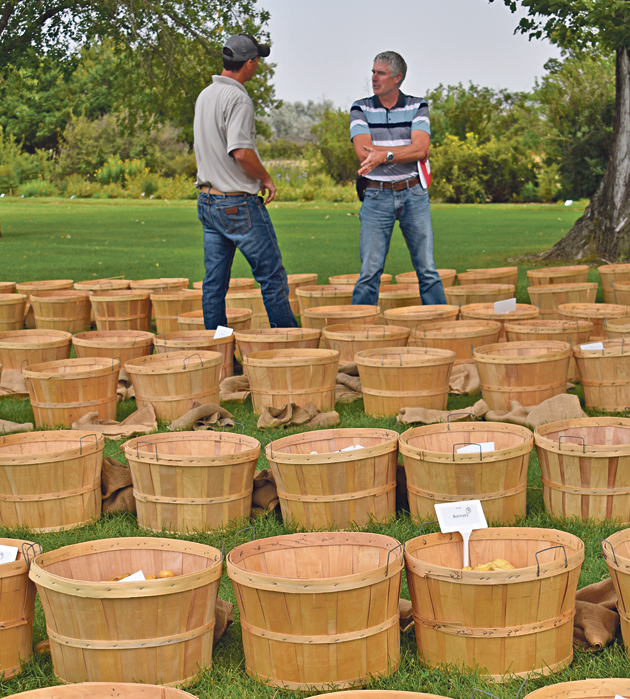More than 100 separate bushel baskets of potatoes, each containing the production from 10 hills, are lined up on the grass at the Crop Diversification Centre South in Brooks, Alberta. Each contains a different variety of potatoes, some of them tried and true, others being considered for multiplication and future production.
“Breeding is a long-term process which takes about 10 to 12 years to get to the market,” says Benoit Bizimungu, chief potato breeder with Agriculture Canada. “We start every single cycle with a really huge amount of different potato varieties…. We screen from 100,000 potential varieties every year. It’s a very long-term process but also a complex one. From that 100,000 we start [with] every year, the expectation is to get hopefully one or two varieties.”
 There is a lot to consider when breeding potatoes because end use has major implications. Is the variety destined for the fresh table potato market? Are there consumer trends in terms of shape or color? Will the potatoes become french fries or potato chips? Will they need to be stored for long periods and, if so, will they store well? Does the variety produce tubers of the right shape and texture for the designated end use? Where will it grow best?
There is a lot to consider when breeding potatoes because end use has major implications. Is the variety destined for the fresh table potato market? Are there consumer trends in terms of shape or color? Will the potatoes become french fries or potato chips? Will they need to be stored for long periods and, if so, will they store well? Does the variety produce tubers of the right shape and texture for the designated end use? Where will it grow best?
Bizimungu says Agriculture Canada addresses the latter question by having seven test sites across the country.
“In every major production area, we have a trial site to see which ones have local adaptation,” he says. “Some varieties actually have a wide adaptation. They do very well in each environment … Especially for the processing, that’s a good thing to have because you have some consistency.”
Bizimungu said the potatoes on display at this field day Aug. 24 are essentially an adaptation trial showing varieties selected at the research stage. The next step is to see how they adapt to different environments.
“It’s the selection process after that, that makes the difference,” says Alberta Agriculture potato research specialist Michele Konschuh. “They will select varieties that have attributes that are of interest to industry. They are looking for all sorts of things: yield, french fry shape and color. They’ll be looking for cold temperature storage. They’ll be looking for palatability and disease resistance and things like that.”
Varieties with promise are grown in trials, and a short list is then offered to industry for evaluation. After a few years of testing, there is a sealed bid process in which companies can bid exclusively or non-exclusively for the North American or global rights. Successful bidders can then take the variety forward, build a seed supply and start commercial production.
“It’s really a dance to try to get good material out there for them to evaluate and then to ensure that the people who have decision-making capabilities to select those varieties and move them forward, we just try to pair them up. It’s like speed dating,” says Konschuh.
Ed Vandenberg, chair of Potato Growers of Alberta, says research is vital to the industry’s health.
“We’d always like to see more, but we’re definitely very supportive of the work that is done here,” says Vandenberg. “It’s very important to us that we are progressive in finding new varieties … for disease issues and better use of nitrogen, more efficient use of water. If we’re going to be a progressive area, which I believe we are, we have to continually look for new varieties. We also have to work with our market to ensure that they are happy with the new varieties because it is really one industry, and we all have to work together as a team to bring these new varieties to market acceptance.”
Alberta’s potato industry is worth about $1 billion annually, even though the province is more widely known for its beef than its potatoes.
“We consider ourselves the side dish for beef,” says Konschuh.
Potato harvest in Alberta is well under way. Vandenberg says harvest for potato chip varieties began in early to mid-August and harvest of french fry and storage potatoes around Sept. 10.
“Mostly I think it looks promising, under the irrigation, as long as people could keep the pivots running,” he says.
Source: Western Producer